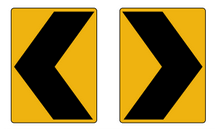
Correct Answer: Chevron, slow for curve.
The sign in question is a chevron, frequently used to denote an upcoming curve in the road. The phrase "slow for the curve" further solidifies this interpretation by telling drivers to slow down as they approach the curve. Thus, "Chevron, slow for the curve" is the correct response.
Correct Answer: Traffic signal ahead.
There is a traffic signal ahead, as indicated by the sign in the question. This sign alerts drivers to the impending traffic signal and advises them to modify their speed accordingly. When approaching a traffic signal, it is crucial to reduce speed, drive cautiously to maintain safety and be ready to stop if needed.
Correct Answer: Caution, School Zone.
Because the sign features a picture of a schoolhouse and a group of kids strolling, "Caution, School Zone" is the appropriate response. This sign is frequently used to alert drivers to the presence of a school in the area and advises them to drive more slowly to protect pedestrians, particularly young children, who may be crossing the street.
Correct Answer: Curve, slow to 35 MPH.
This sign warns motorists to slow down to 35 miles per hour as there is a curve ahead. It is crucial to reduce your speed to negotiate the curve safely and prevent any possible collisions.
Correct Answer: Flagger ahead, slow down and prepare to stop for roadwork.
The signs in the question tell drivers to slow down and be ready to stop for roadwork because there is a flagger ahead. This is crucial to guaranteeing the security of both motorists and roadside laborers. The other choices—bullfighter, scooper ahead, and pullover to the shoulder of the road—do not appropriately convey the signs' meaning.
Correct Answer: No U-Turn.
The sign in the question reads "No U-Turn," which indicates that turning around in a car is not permitted at that location. U-turns, which involve turning a vehicle around in the other direction, are generally forbidden where they could endanger public safety or impede traffic flow. "No U-Turn" is the appropriate response as a result.
Correct Answer: Keep to the left of obstruction
"Keep to the right of obstruction" is the appropriate response since it tells the person to remain on the right side of the obstruction. This is crucial to preserving security and preventing any possible collisions or accidents. The individual can ensure they are driving in the proper lane and staying clear of any potential road hazards by adhering to this instruction.